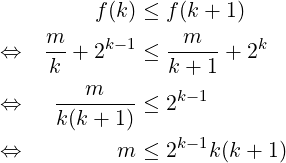
[This page is auto-generated; please prefer to read the article’s PDF Form.]
We can choose the value of integer k (k ≥ 2) which minimizes the number of multiplications in (1) for a given m, which means to minimize:
 |
For m > 8, as k increases from 0 to higher integers, f(k) first keeps decreasing and then keeps increasing. So, to find integer k where f(k) is minimum, we will look for the integer k at which this f(k) increase starts. More precisely, we need the smallest integer k satisfying:

The below table shows some ranges of m and their optimal k value:
| m | 9–12 | 13–48 | 49–160 | 161–480 | 481–1344 | 1345–3584 | 3585–9216 |
| k | 2 | 3 | 4 | 5 | 6 | 7 | 8 |
Consider some m > 8, and let ko denote the corresponding optimal k. Then, N(ko) must not exceed N(k) for any integer k ≥ 2. So, N(ko) ≤ N(2). But, as seen in (2), for all m > 8, N(2) < Nb. Thus,
 |
In other words, for all m > 8, the number of multiplications required by 2k-ary algorithm with optimally chosen k is always less than that required by Binary LR algorithm.
The number of multiplications saved by this algorithm, compared to the Binary LR algorithm, become more significant as m increases. For example, with m = 18 and m = 52, the Binary LR algorithm requires (2(m− 1) =) 34 and 102 multiplications, but this algorithm requires (due to (1)) 18 + (18∕3) + 22 = 28 (k = 3) and 52 + (52∕4) + 23 = 73 (k = 4) multiplications respectively.
■
Copyright © 2021 Nitin Verma. All rights reserved.